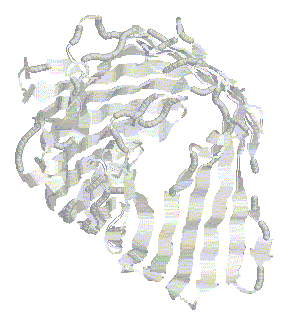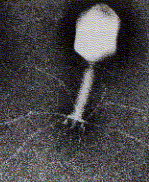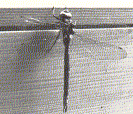What the Figures Show
 |
Protein All life depends on the activity of proteins. They are made of amino acids arranged in a linear sequence. The information for synthesizing the amino acid strings is found in DNA or genes. The figure shows a part of a bacterial cell wall protein called porin. It forms small pores across the outer part of the cell wall functioning as a sieve protecting the cell against toxic proteins but allowing the uptake of small nutrients. Some 12,000 plus protein structures are known/ This number constitutes only a small fraction of all possible protein structures of all living organisms combined. Size of particle about 10 nanometers = 0.00000001 meter. |
 |
Bacteriophage The Bacteriophage T4 is a virus infecting bacterial cells such as that of E.coli. The large head is a protein coat protecting the viral genome (DNA) which will be injected into the bacterium after the virus attaches to the bacterial cell wall surface using its filamentous tentacles to recognize the specific host bacterium. T4 is a member of phages with contractile tails (long rod connecting head and fibrils). Size of organism 200 nanometers. |
 |
Mitosis The separation of chromosomes during cell division. This process is found in all eukaryotic organisms such as worms, flies, plants, and animals. It is important for growth and development. The picture shows the anaphase where each chromatid pair separates into two identical chromosomes that are pulled to opposite ends of the cell by the spindle fibers. Size of eukaryotic cell 10 micrometers. |
|
|
Roundworm Caenorhabditis elegans is a soil nematode found in temperate regions and is used a model organism by biologists since the 1960s. Its complete genome has been published in 1999. Each worm is composed of exactly 1333 cells, including those used only during development but die before the worm reaches its adult stage with 959 somatic cells. Thus, a complete developmental history for each cell can be described in detail. It has a primitive nervous system. Size of organism is 1 million nanometers or 1,000 micrometer = 1 millimeter. |
 |
Dragonfly Insects like dragonflies are one of the most successful group of animals on earth. The body plan of dragonflies appears to be several hundred million years old and conserved in insects, with some genetic elements conserved in higher animals, also body segmentation looks different. World wide there are 29 families and over 5,000 species of dragonflies and damselflies (order Odonata) alone. Size is less than 10 centimeter. A genome representing insects is that for Drosophila melanogaster, a fruit fly. This is the first animal genome sequenced and its importance comes from the importance of Drosophila as an experimental system in genetics. |
 |
Plant Plants are so called photoautotrophic organisms. This means they can live from light energy and inorganic material alone - carbon dioxide, water, and many minerals (containing phosphorus, nitrogen, sulfur etc.). Plants produce most of the bio mass on earth and the survival of animals including humans is completely dependent on their existence underlining the importance of agriculture and a clean environment. In 2000 the first complete genome of a plant model organism - Arabidopsis thaliana - has been published. Other plant species have since been genetically sequenced including rice (Oryza sativa) and corn (Zea Mays), two major food crops. |
 |
Human We Humans give ourselves a special place in Nature that allows the development of an artificial culture (environment) not found anywhere else in Nature, but which affects all other organisms one way or another. As a living organism man is closely related to all other life forms and its evolutionary history of life has been well described. Humans depend on food for their survival, food that only comes from other organisms - vegetarian or animal based. The human genome project (Homo sapiens) has been finished in April of 2003 and puts a astonishing finishing mark to the success of the biological and medical sciences of the 20th century. Sequencing is now pushed to include the diploid sequences of many individuals, as can be followed by the 1000 Genome Project at NCBI. In addition, both the genomes of Neanderthals as an extinct homo species and the chimpanzee (Pan troglodytes) genome as our closest relative in the animal kingdom help shed light on our evolutionary history as recorded in the genomes. |
Copyright © 2000-2012 Lukas K. Buehler
All rights reserved